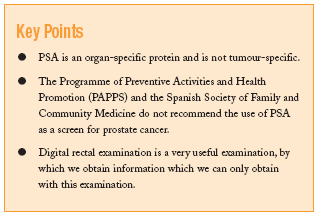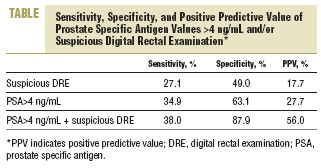Prostate specific antigen (PSA) is a protein synthesised in the prostate tissue. Its main function is to liquefy the seminal coagulate and facilitate the transport of spermatozoa through the vas deferens to the urethra. Its application in clinical practice is based on its use as an immunological marker of prostate cancer, both in screening and in the follow up of this neoplasia. However, on being an organ specific protein and not a tumour specific one, it can be elevated without there being prostate cancer. Thus, for certain values of PSA it does not have an increased specifity and does not allow a clear distinction between benign prostatic hyperplasia (BPH) and localised prostate neoplasia.1
With the aim of increasing the specificity of this screening test, that is, to diagnose the same number of neoplasias but reducing the number of negative biopsies and the consequent anxiety which arises from this suspected diagnosis in patients, different ways of quantifying serum PSA values have been proposed.
These different ways of evaluating PSA2,3 have a special use in the so-called "grey area" (or maximum overlap between the possibility that the increased PSA may be the consequence of benign or malignant prostatic disease), which is situated in the values of PSA between 4 ng/mL and 10 ng/mL.
Although some scientific societies recommend the use of PSA for the screening of prostate cancer, other societies do not recommend its use, because they consider that, currently, there is not sufficient proof to demonstrate that a screening programme might have an impact on the morbidity and mortality due to prostate cancer. In our country the Programme of Preventive Activities and Health Promotion (PAPPS) and the Spanish Society of Family and Community Medicine do not recommend it.4
A recent study published in JAMA points out that no PSA value offered sufficient reliability for screening and demonstrates that at no cut-off point can a specifity and sensitivity be found at least reasonably close.5
On the other hand, what effect the fact of adding digital rectal examination to the PSA has on the positive predictive value, the sensitivity and specificity can be seen (Table).6 Thus, if the patient has opted for screening for prostate cancer, this must be optimised by looking to increase the sensitivity by using the PSA together with digital rectal examination.
Digital rectal examination is a very useful examination, easy to perform, by which we obtain information which we can only obtain by carrying out this examination, and will be important when deciding subsequent action (diagnosis and treatment). It is a straightforward examination within the capabilities of all doctors. The argument of inexperience is not valid, given that it is an examination which should be performed frequently, and it will be this frequency which will enable us to have and maintain the necessary skill. Digital rectal examination is an essential element within the basic package of physical examinations carried out by any primary care doctor.
With the performing of digital rectal examination we will obtain data which will enable us to evaluate the morphology, the size, the consistency, the mobility, the regularity of its limits, the presence of nodules and the sensitivity of the prostate.7










